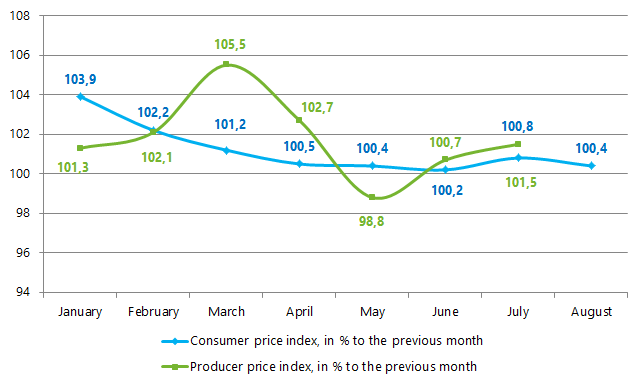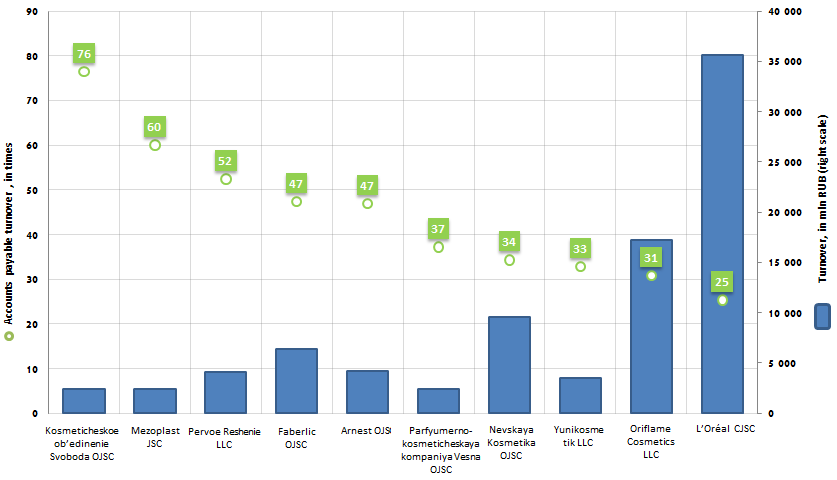Predicted target figure on inflation is 4%
Based on the results of August 2015 the consumer price index (CPI) recorded a 0,4 percentage point (pp) increase compared to July 2015. However, the growth dynamics of the increase in prices is still lower in comparison with the situation in July. Then the increase made 0,8 pp compared to May 2015 (Picture 1). It should also be noted that prior to August 18, 2015 it was recorded the zero inflation four weeks in a row, and from the 11th till 17th of August the average price increase pointed even to a symbolic deflation. And the producer price index increased by 1,5 pp in July 2015 compared to the previous month.

Picture 1. Change in the consumer price index and producer prices for the period January-August 2015
In the whole, the inflation on the CIP is marked at the level of 15,8% as of September 1, 2015 (s. Picture 2), following the results of 6 months – 9,6%. The producer price index reached 13,1% at an annual rate, following the results of 6 months – 12,6%.

Picture 2. Change in consumer and producer price index at an annual rate
An analysis of inflationary trends showed that the inflation rate after August 20, 2015 was caused by the devaluation of the ruble, which occurred as a result of the reduction of world oil prices and other factors. So, on the 24th of August at 08.30 MST, October futures for Brent crude oil cost 44,34 USD per barrel. As of 16.44 MST price fell down - up to 42,92 USD per barrel. During the bidding the lowest drop in futures prices reached 42,54 USD per barrel, approaching in such a way to a minimum of March 12, 2009 - at the rate of 42,19. Against this background, the exchange rate did not reach a bit 71 rubles per dollar.
Prevailing conditions led to the fact, that the Russian government institutions involved in the forecast of macroeconomic indicators developed the worst scenarios of development of Russian economy. The Ministry of Economic Development expects the inflation rate at 11,9% at the end of 2015, the Ministry of Finance – 11,9%, the Central Bank of the RF - 12-13%. In 2016 the Ministry of Economic Development predicts 8,8%, the Ministry of Finance – 7,0%, the Central Bank of the RF – 5,5-6,5%. However, the Regulator intends finally to reduce the inflation up to a level of 4% in 2017.
The Bank of Russia intends to reach the target figure on inflation within its monetary policy through the following instruments:
- the use of inflation targeting regime;
- the use of a number of non-standard instruments to provide liquidity to banks;
- the impact on the price of money in the economy via interest rates;
- the adherence to a floating exchange rate;
- the formation of inflation expectations at a stable low level, etc.
Also the Bank of Russia will continue to ensure a stable functioning and development of the banking sector, financial market and payment system. By conducting of monetary policy the Regulator will develop the mechanisms of interaction with federal executive authorities in the field of tariff regulation, tax policy, management of remaining budgetary funds on accounts of the Bank of Russia. The reaching of the target figures will largely depend on measures of the Government of the RF aimed to ensuring of a balanced budget and consistent implementation of structural reforms in the Russian economy.
Accounts payable turnover of manufacturers of perfumery products
Information agency Credinform prepared a ranking of Russian perfume companies.
The companies with the highest volume of revenue were selected for this ranking according to the data from the Statistical Register for the latest available period (for the year 2013). These enterprises were ranked by increase in values of accounts payable turnover.
Accounts payable turnover/ payables turnover (in times) is the relation of average accounts payable for the period to sales revenue. The ratio shows, how many times (a year, a s a rule) an enterprise has discharged the average amount of its accounts payable.
The ratio of accounts payable turnover reflects the process of debt repayment to contractors (partners, suppliers, dealers etc). The ratio determines the number of debts satisfied by a firm and is calculated to estimate the cash flows, that allows to draw conclusions about the operating efficiency of an enterprise and chosen financial strategy of the management.
The higher is the mentioned ratio, the soonest a company pays up debts to its supplies. Decline in turnover can mean as well problems with the settlement of accounts, as a more effective organization of relationships with suppliers, which provides a more convenient, deferred payment plan and uses the accounts payable as a source of getting of cheap financial resources.
For getting of the most comprehensive and fair picture of the financial standing of an enterprise it is necessary to pay attention not only to industry-average indicators, but also to all presented combination of financial indicators and company’s ratios.
| № | Name | Region | Revenue, in mln RUB, for 2013 | Accounts payable turnover, in times | Solvency index GLOBAS-i® |
|---|---|---|---|---|---|
| 1 | Kosmeticheskoe ob’edinenie Svoboda OJSC INN 7714078157 |
Moscow | 2 437 | 76 | 266 high |
| 2 | Mezoplast JSC INN 7721025967 |
Moscow | 2 443 | 60 | 231 high |
| 3 | Pervoe Reshenie LLC INN 7701298966 |
Moscow | 4 071 | 52 | 269 high |
| 4 | Faberlic OJSC INN 5001026970 |
Moscow | 6 383 | 47 | 158 the highest |
| 5 | Arnest OJSC INN 2631006752 |
Stavropol region | 4 207 | 47 | 221 high |
| 6 | Parfyumerno-kosmeticheskaya kompaniya Vesna OJSC INN 6311064600 |
Samara region | 2 402 | 37 | 222 high |
| 7 | Nevskaya Kosmetika OJSC INN 7811038047 |
Saint-Petersburg | 9 607 | 34 | 172 the highest |
| 8 | YunikosmetikLLC INN 7826704356 |
Saint-Petersburg | 3 484 | 33 | 169 the highest |
| 9 | Oriflame Cosmetics LLC INN 7704270172 |
Moscow | 17 212 | 31 | 276 high |
| 10 | L’Oréal CJSC INN 7726059896 |
Moscow | 35 624 | 25 | 221 high |
Accounts payable turnover of the largest manufacturers of perfumery (TOP-10) ranges from 76 days (Kosmeticheskoe ob’edinenie Svoboda OJSC) up to 25 days (L`Oreal CJSC). As it can be seen from the picture, the higher is the annual turnover of the company, the less number of times it can repay its debts to the contractors.

Picture 1. Accounts payable turnover and revenue of the largest manufacturers of perfumery products (TOP-10)
Annual revenue of the TOP-10 market leaders made 87,9 bln RUB, following the results of the latest published financial statement (for 2013), that is by 6,1% higher than in the previous reporting period.
Payables turnover of the leader on turnover of the Russian market of perfumery products, the company L`OREAL CJSC, is below the average values of the TOP-10 group - 25 times a year on the average.
The history of L'Oréal in Russia has been starting since 1990, when a Soviet-French joint venture was founded, which manufactured shampoos Elsève, hair dyes Recital and perfumes Maroussia.
The Russian branch of L’Oréal was organized in 1994 and until 2003 it was known as Rusbel CJSC, in 2003 it was renamed into L’Oréal CJSC. Activity of the branch began with the promotion of goods under the brands “L’Oréal Paris” and “Laboratoires Garnier” in the framework of mass-market products.
Today, L'Oréal is present in all distribution channels in Russia: beauty salons, pharmacies, supermarkets, and an exceptional range of brands takes a leadership position in many market segments, such as make-up, hair care, body care, perfumery etc.
The second company of the industry, Oriflame Cosmetics LLC, leads his longtime rival in the speed of accounts payable turnover (31 times).
Oriflame is the leading cosmetics company in the market of direct sales. The company's products are represented in more than 60 countries, and more than a half of them occupies a leading position in the market.
All participants of the TOP-10 list got high and the highest solvency index, this fact points to companies’ ability to pay off their debts in time and fully, while risk of default is minimal.